Generator Market Research, 2032
The global generator market was valued at $45.9 billion in 2022, and is projected to reach $74.1 billion by 2032, growing at a CAGR of 4.8% from 2023 to 2032.
Key Report Highlighters:
- The report outlines the current generator market trends and future scenario of the market from 2023 to 2032 to understand the prevailing opportunities and potential investment pockets.
- The global generator market has been analyzed in terms of value ($ million). The analysis in the report is provided for 4 major regions and more than 15 countries.
- The generator market is fragmented in nature with few players such as Caterpillar, General Electric, Kirloskar Oil Engines Ltd., Generac Holdings Inc., Kohler Co., AKSA POWER GENERATION, Su-Kam, Cummins Inc., ABB Ltd., and Mitsubishi Electric, which hold significant share of the market.
- The report provides strategy planning and industry dynamics to enhance decision making for existing market players and new entrants entering the generator market.
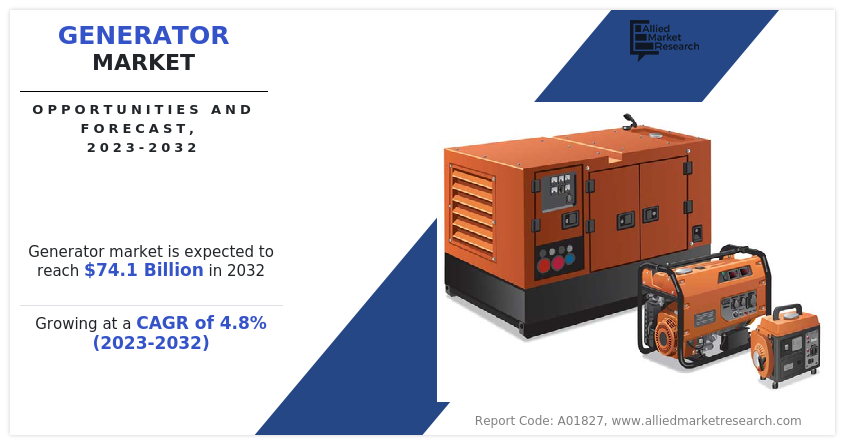
Energy from mechanical sources can be transformed into electrical energy using a generator. It functions on the basis of Michael Faraday's early 19th-century discovery of electromagnetic induction. In order to produce electricity for a variety of uses, including lighting up homes and businesses and delivering electricity in remote locations and during emergencies, generators are essential. It consists of different components such as prime mover, motor, stator, magnetic field, and outer terminals.
Prime Mover: This is the component that provides the mechanical energy to drive the generator. It is an engine, a turbine, or any other device that rotates the generator's rotor.
Rotor: The rotor is a part of the generator that rotates within a magnetic field. When it turns, it induces an electrical current in the stator.
Stator: The stator is the stationary component of the generator that surrounds the rotor. It contains coils of wire, and when the rotor rotates, it induces an electrical current in these coils.
Magnetic Field: A generator needs a magnetic field to function. In some generators, this field is created by permanent magnets, while in others, it is generated by passing an electric current through a coil.
Output Terminals: The electrical current produced by the generator is delivered to the outside world through output terminals. These terminals are where you connect electrical devices or an electrical grid to receive the generated electricity.
Generators are used in different applications for backup to provide power during electrical outages. Small, portable generators are used for camping, outdoor events, and as backup power sources. Large generators are used in industries to supply power to machines and equipment. Generators in power plants, often driven by turbines, are used to generate electricity on a large scale. Generators are used in remote areas without access to the electrical grid.
Generators provide a reliable source of power during blackouts, ensuring uninterrupted operation in critical applications. They are used in various settings, from residential homes to large industrial complexes. Many generators start automatically when a power outage occurs, reducing downtime. Generators come in various sizes and power capacities, making them adaptable to different needs. Remote areas and off-grid locations benefit from generators, providing access to electricity where grid connections are not feasible.
Generators typically require a fuel source, such as gasoline, diesel, or natural gas, which is a recurring cost and a source of emissions. Some generators are noisy and produce exhaust emissions, which be a concern in residential and environmentally sensitive areas. Generators require regular maintenance to ensure they function properly when needed. High-quality generators are expensive, and installation costs add to the overall investment. Portable generators have a limited run time based on fuel capacity, requiring periodic refueling.
As power reliability becomes increasingly important, there is a growing demand for generators in residential, commercial, and industrial sectors. Generators complement renewable energy systems by providing backup power during periods of low renewable energy production. Generators provide opportunities to bring electricity to remote and off-grid regions, supporting economic development.
Market Dynamics
As global energy consumption continues to rise, there is a growing need for reliable power sources. Generators play a vital role in meeting this demand, particularly during peak usage periods or in regions with unreliable grid power. Power outages due to weather events, natural disasters, or aging infrastructure have highlighted the importance of backup power sources. Generators provide a reliable solution for ensuring uninterrupted power supply, especially in critical applications like hospitals and data centers.
Expanding industries and manufacturing sectors require stable and continuous power sources to maintain production. Generators are a crucial component of industrial infrastructure to prevent costly downtime. In many developing regions, extending electrical grid infrastructure is expensive and challenging. Generators provide a cost-effective means of electrifying rural and remote areas. Construction projects, infrastructure development, and mining operations often take place in areas with limited grid access. Generators power tools and machinery at these sites.
Emissions and noise pollution associated with some types of generators are a significant restraint, especially in urban and environmentally sensitive areas. Stricter environmental regulations impact the market. The global transition toward cleaner and renewable energy sources reduces the reliance on generators in some areas. Battery storage and other energy storage solutions are becoming alternatives.
Generators, especially high-quality models, and those designed for large-scale applications, have a significant upfront cost, which deters potential buyers. Generators require ongoing maintenance to ensure proper functionality, and these maintenance costs add to the overall ownership expenses. The price and availability of fuel sources, such as diesel or natural gas, impact the operating costs of generators.
Generators complement renewable energy systems by providing backup power during periods of low renewable energy production. As the adoption of renewable energy sources increases, the demand for generators that work in conjunction with these systems is on the rise. Combining generators with energy storage solutions, like batteries, presents an opportunity to create hybrid power systems. These systems provide greater flexibility and reliability by storing excess power and using it during peak demand or power outages.
The generator market analysis is done on the basis of type, voltage rating, application, end-use industry, and region.
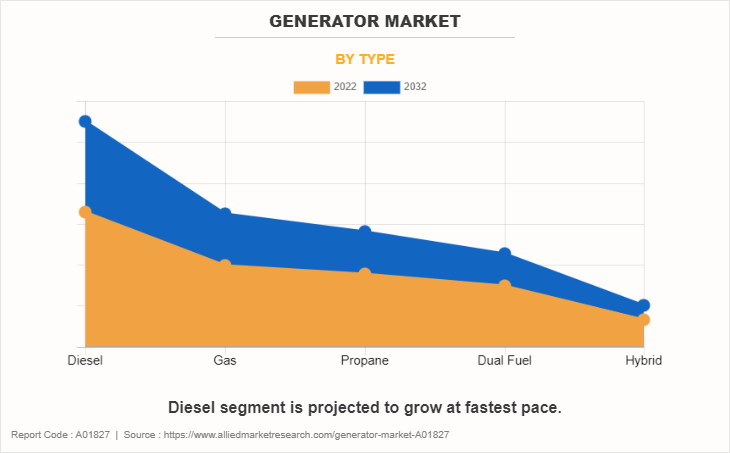
By type, the generator market size is divided into diesel, gas, propane, dual fuel, and hybrid. The diesel segment dominated the market growth and the same is projected to grow at a higher pace during the projection years offering several Generator Market Growth. The diesel fuel is used in generators and offers higher efficiency thus it is used majorly for the power generation. The need for reliable backup power solutions continued to drive the diesel generator market, particularly in regions with unreliable electrical grids or areas prone to natural disasters. Industries like healthcare, data centers, manufacturing, and telecommunications rely on backup power sources, often supplied by diesel generators.
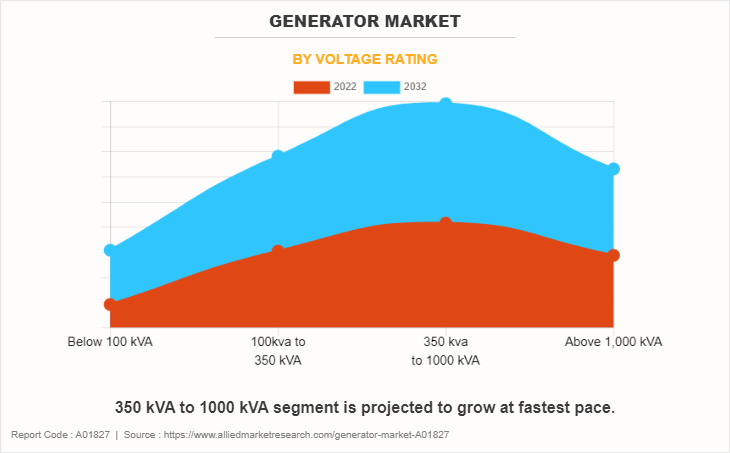
By voltage rating, the market is classified into below 100 kVA, 100kva to 350 kVA, 350 kVA to 1000 kVA, and above 1,000 kVA. The 350 kVA to 1000 kVA dominated the generator market share for 2022. It is projected to continue its dominance throughout the generator market forecast period. The demand for generators in this range was on the rise across various sectors, driven by the need for reliable backup power solutions to mitigate the impact of power outages and grid instability. With the expansion of data centers to support cloud computing and digital services, medium-sized generators are in demand to ensure uninterrupted power for critical IT infrastructure.
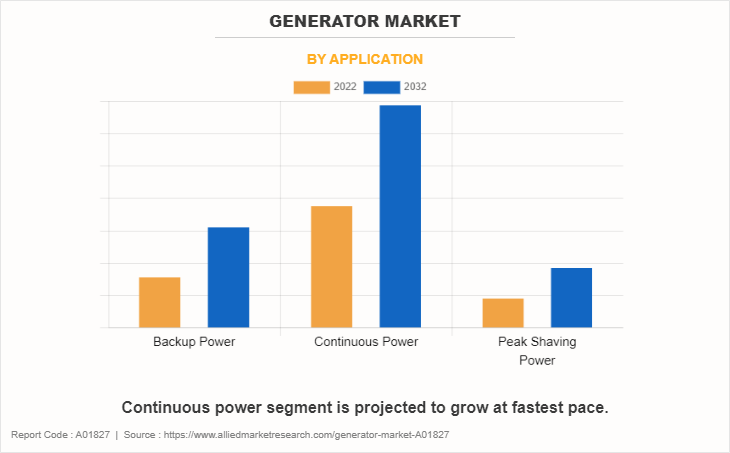
By application, the market is categorized into backup power, continuous power, and peak shaving power. The continuous power segment is projected to maintain its dominance throughout the forecast period. The need for continuous and reliable power supply was growing across various sectors, including data centers, healthcare, telecommunications, and manufacturing. The trend toward always-on operations necessitated robust continuous power solutions.
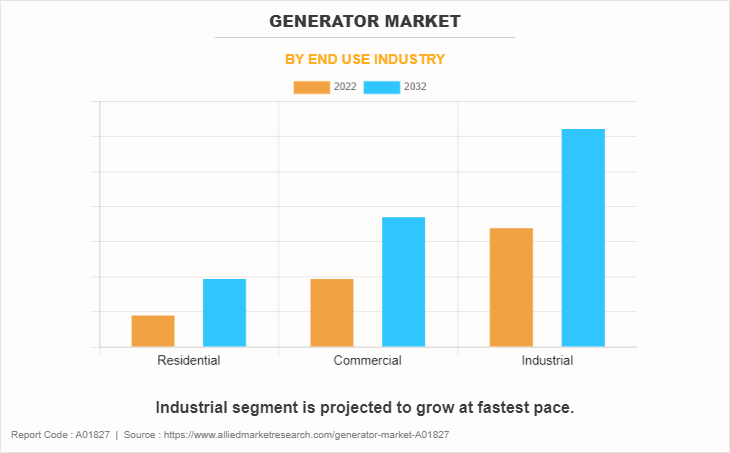
By end-use industry, the market is segregated into residential, commercial, and industrial. The industrial sector garnered highest market share for 2022 and is projected to continue its growth at a higher pace during the studied generator market scope. Industrial generators are capable of producing a significant amount of electrical power, typically ranging from several kilowatts (kW) to megawatts (MW) to meet the varying demands of industrial facilities. These generators are built to withstand continuous use and are equipped with robust components, making them suitable for demanding industrial environments.
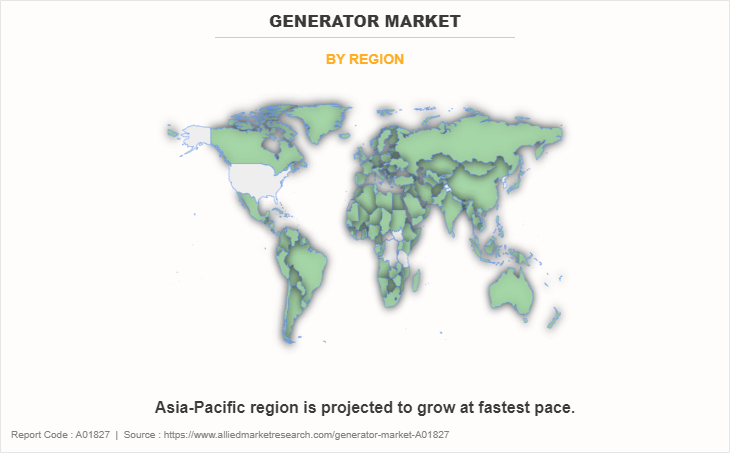
By region, the generator market analysis is done across North America, Europe, Asia-Pacific, and LAMEA (Latin America, the Middle East, and Africa). The Asia-Pacific region is projected to grow at the fastest pace during the forecast period. China's quick industrialization, urbanization, and the demand for dependable power sources across numerous industries are what are driving the country's generator industry. India's diversified topography, problems with the nation's power grid, and rapid economic development all influence the generator industry there. When it comes to irrigation, crop management, and livestock care, generators are indispensable in agriculture. To maintain continuous electricity for life-saving equipment, hospitals and other healthcare facilities rely on generators.
The major players operating in the generator industry are Caterpillar, General Electric, Kirloskar Oil Engines Ltd., Generac Holdings Inc., Kohler Co., AKSA POWER GENERATION, Su-Kam, Cummins Inc., ABB Ltd., and Mitsubishi Electric. The companies adopted key strategies such as collaboration to increase their market share.
Key Benefits For Stakeholders
- This report provides a quantitative analysis of the market segments, current trends, estimations, and dynamics of the generator market analysis from 2022 to 2032 to identify the prevailing generator market opportunities.
- The market research is offered along with information related to key drivers, restraints, and opportunities.
- Porter's five forces analysis highlights the potency of buyers and suppliers to enable stakeholders make profit-oriented business decisions and strengthen their supplier-buyer network.
- In-depth analysis of the generator market segmentation assists to determine the prevailing market opportunities.
- Major countries in each region are mapped according to their revenue contribution to the global market.
- Market player positioning facilitates benchmarking and provides a clear understanding of the present position of the market players.
- The report includes the analysis of the regional as well as global generator market trends, key players, market segments, application areas, and market growth strategies.
Generator Market Report Highlights
| Aspects | Details |
| Market Size By 2032 | USD 74.1 billion |
| Growth Rate | CAGR of 4.8% |
| Forecast period | 2022 - 2032 |
| Report Pages | 300 |
| By Application |
|
| By End Use Industry |
|
| By Type |
|
| By Voltage Rating |
|
| By Region |
|
| Key Market Players | General Electric, Caterpillar, Kohler Co., Su-kam., AKSA POWER GENERATION, Generac Holdings Inc., Cummins Inc., ABB Ltd., Mitsubishi Electric, Kirloskar Oil Engines Ltd |
| | Others |
Analyst Review
According to the insights from the CXO’s, with respect to different kinds of generators and applications, the generator market is a substantial sector of the worldwide power generation industry. Electricity supply from this market is essential for a variety of applications, including emergency backup power, industrial, residential, and commercial. The need for dependable power generation is being driven by the surge in worldwide energy demand, especially in emerging nations, which drives the generator industry. The need for backup power is a factor that requires generators, particularly in vital establishments such as data centers and hospitals. When it comes to intermittent renewable energy sources such as wind and solar, generators are important for system stability and backup. Cleaner power generation techniques are encouraged by emission laws and environmental awareness, which has an effect on generators that run on fossil fuels. Generator functioning and economics are influenced by the cost and availability of fuels, such as natural gas and diesel. Certain applications no longer require traditional generators due to advancements in battery and energy storage technology
Increasing power demand amidst power outage concerns and industrialization, rural electrification, and development in construction & infrastructure are the upcoming trends of Generator Market in the world.
Asia-Pacific is the largest regional market for Generator.
Continuous power segment is the leading application of Generator Market.
$74.1 billion is the estimated industry size of Generator by 2032.
Caterpillar, General Electric, Kirloskar Oil Engines Ltd., Generac Holdings Inc., Kohler Co., AKSA POWER GENERATION, Su-kam, Cummins Inc., ABB Ltd., and Mitsubishi Electric are the top companies to hold the market share in Generator.
Loading Table Of Content...
Loading Research Methodology...


